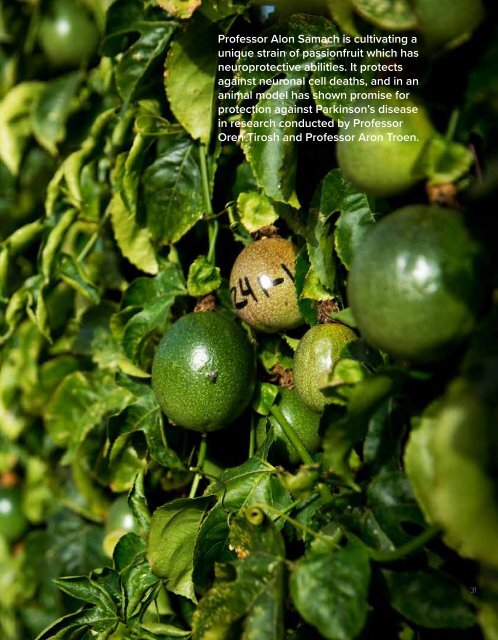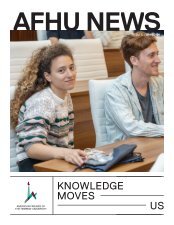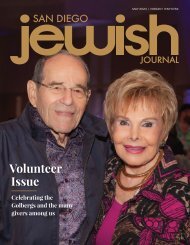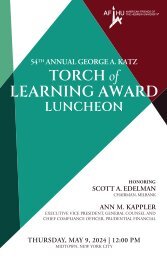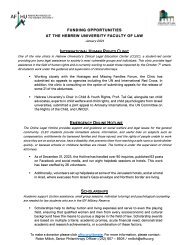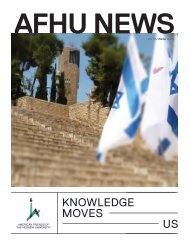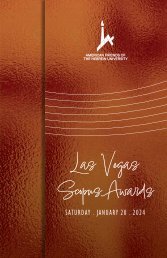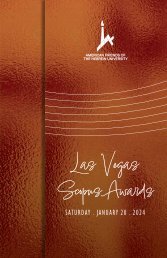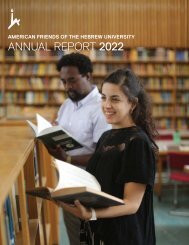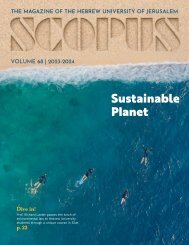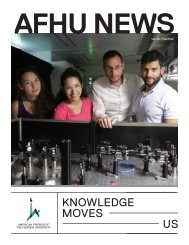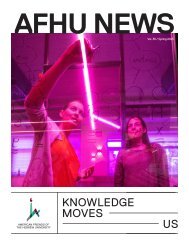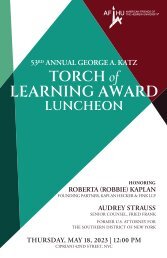Create successful ePaper yourself
Turn your PDF publications into a flip-book with our unique Google optimized e-Paper software.
Our<br />
Second<br />
Century<br />
by Yaron Daniely, PhD, MBA<br />
President & CEO, Yissum<br />
As we turn the page on our first one hundred had perfected a consistent methodology of innovation<br />
pioneering, miraculous years of the Hebrew University,<br />
patenting and intellectual property licensing as<br />
we begin charting the chronicles of our their core activities. For some, this model provided<br />
second century. Tempting as it may be, reminiscing an adequate, if sometimes unpredictable, stream of<br />
about all that has been achieved so far must not income. However, numerous surveys suggest that<br />
distract us from planning for the challenges and the overwhelming majority of TTOs have not been<br />
opportunities that lie ahead. Our preparedness for successful in generating adequate returns over the<br />
Reminiscing about<br />
the drastic transformations occurring globally in past decade to cover their operational expenses.<br />
education and innovation will decide the fate of our As the rate of royalty-bearing licenses remains flat<br />
all that has been<br />
University.<br />
at approximately 0.5 percent (i.e., only one in 200<br />
For most of the past one hundred years, licensing transactions will generate $1M or more<br />
universities were the preeminent and irreplaceable in royalty payments annually), TTOs are facing<br />
achieved so far<br />
source of novel inventions. Industry huddled at the insurmountable task of completing over 600<br />
their institutional gates as it sought to source licensing deals to achieve that one, $1M-bearing<br />
must not distract<br />
solutions and develop products for their customers. royalty paying license. The numbers are staggering,<br />
The emergence of the internet in the early 1990s given that 600 completed licenses will mean an<br />
dramatically impacted the role of universities and additional 1,200 technologies that the TTO will<br />
us from planning<br />
stripped them of their exclusivity in generating record, protect, and promote without attracting a<br />
innovations and skilled entrepreneurs. This technological<br />
partner. Note that the average rate of technology<br />
for the challenges<br />
revolution displaced the historic role<br />
coping with its repercussions.<br />
licensing is 30 percent at westernized academic and<br />
TTOs have typically dealt with this change in<br />
of academic research institutions and we are still research institutions.<br />
and opportunities<br />
In particular, this paradigm shift impacted one of three ways. Many went on the defensive,<br />
university Technology Transfer Organizations clutching their intellectual property assets ever<br />
that lie ahead.<br />
42 (TTOs) across the world. Many such organizations more tightly and elevating the barriers to their com-<br />
and innovation.<br />
43<br />
mercialization, hoping to make better financial<br />
transactions with a more lucrative upside in case<br />
of success. This approach is likely to keep more<br />
university-based technologies on campus, and away<br />
from opportunities that can translate them into<br />
commercially-viable products. It is also fraught<br />
with the danger of alienating faculty members and<br />
students who pursue translational research through<br />
collaboration and dissemination.<br />
The second way to handle the challenge is<br />
to try and improve the odds; if a TTO is able to<br />
commercialize more than just 30 percent of its<br />
inventions, or if it is able to improve upon the 0.5<br />
percent success rate of royalty-bearing licenses,<br />
the numbers will shift to the TTO’s benefit. The<br />
challenge in this method is in its implementation.<br />
TTOs focused on increasing odds generally invest<br />
in becoming better “fortune tellers,” operating<br />
under the assumption that the TTO has unique<br />
capabilities to identify what inventions are more<br />
likely to attract partners, and which partners are<br />
more likely to drive long-term success. But by<br />
focusing on TTO expertise and internal knowhow,<br />
these TTOs jeopardize two critical missions.<br />
First, they are likely to generate disengagement<br />
from faculty members who view their innovations<br />
as potentially important to the community, even in<br />
the absence of commercial value. Second, they may<br />
be wrong; they may neglect useful innovations and<br />
focus instead on others. In this respect, they will<br />
be in excellent company, joining the President of<br />
Western Union who passed on the opportunity to<br />
commercialize the telephone, and even our revered<br />
Einstein who did not believe in the future of nuclear<br />
energy. But they will be wrong nonetheless.<br />
The third, advisable way to respond to these<br />
tectonic shifts in the TTOs ecosystem is to open,<br />
rather than narrow, our efforts. TTOs deciding to<br />
lower the barriers to commercialization will put<br />
more technologies in the hands of entrepreneurs<br />
and corporations, become transparent, and invite<br />
collaboration. These are the TTOs that will endure<br />
and prosper, while serving their original missions:<br />
to provide opportunities for academic innovation<br />
that translate into beneficial products and solutions,<br />
to be mindful of the needs of the community, and<br />
to respond to those needs with science, technology,<br />
At Yissum, this third approach of opening<br />
up our efforts means many things. It means<br />
realizing that our greatest assets are our faculty<br />
and students, and that patent protection is one of<br />
many ways, but not the only way, to define an asset.<br />
It means creating multiple, flexible channels that<br />
allow entrepreneurs to find the best conduit to<br />
support their technology. It means a continuous,<br />
thoughtful mapping of what our University has<br />
to offer, as well as the construction of a dynamic<br />
interface that allows commercial partners to find<br />
resources within the University. To be open means<br />
to ensure that our contracts and procedures are fair<br />
and represent the best practices for all participants,<br />
and it means leveraging our University resources<br />
to tackle the most complex and critical problems.<br />
Above all, however, to be an open TTO is to create<br />
value through collaboration with our colleagues<br />
within and outside the university.<br />
The innovations of the past century have<br />
made our world smaller. Today, collectively and<br />
individually, we make decisions that will define our<br />
place in tomorrow's world, impacting our children<br />
and grandchildren. At Yissum, we strive to ensure<br />
that the innovations of tomorrow will improve the<br />
world for all of humankind.


